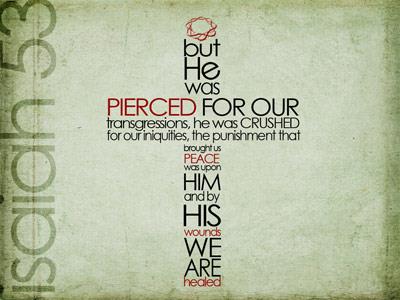-
The Portrait Of The Suffering Servant
Contributed by Nigel Heath on Nov 28, 2017 (message contributor)
Summary: Isaiah 53 the Suffering Servant passage looked upon as though we were seeing it as a painting on display in an art gallery. Suitable for communion.
ADDRESS: THE PORTRAIT IN THE GALLERY - Isaiah 52:13-53:12
INTRO
The unfolding events of Tuesday morning –
Who would have thought what the day would bring
First attack – Bewilderment
Second attack – horror
Third attack – immense shock and panic
Powerful images
Watching the news has been compulsive viewing.
We have seen the same shocking images time and time again.
The world has yet to emerge from the shock of what has happened. Yet already there are the other reactions of anger, despair, questioning and blaming.
POINT It is at times like this that people ask questions about the love and power of God.
Why did God allow this to happen? Some will ask.
There may be no easy answers to this question, but what we do know is:
THESIS God Himself knows suffering enough to be able to care.
POINT Flicking through our newspapers we may have found horrific images.
Flicking through the Bible we find them too.
POINT *This morning we are going to take a look at one of the most powerful of all. It lies in the centre of God’s picture gallery. It takes the form of a song. In the song, God is first to speak.
God has an incredible story to tell. It is all summed up in a picture. God himself tells something of the story, and then he invites us in to see the picture.
(POINT - The reading is Hebrew poetry - not rhyming, but parallels - Note the parallels as we read)
READING Is 52:13-53:12
POINT When I read this passage I imagine it to be like the unveiling of a new portrait drawn for the people. The portrait is that of the Servant of the Lord. Everyone in the crowd is waiting for the portrait to be unveiled (like a new portrait of the Queen). Then the moment arrives and the cover is taken away.
POINT This is not unlike what we have here.
As soon as the portrait is unveiled there is the gasp heard among the crowd – one of shock.
and a SUCCESSION OF RESPONSES:
1. APPALLED - The Portrait Unveiled 52:13-14
IMAGINE
Such pictures should never be shown, we think. The sight is horrific:
It is like a mural - It tells its own story. There are several parts to the picture, but the part that draws our attention most of all is the picture of an intensely tortured body.
The picture is of a Suffering Servant
The Suffering
The form of a person, hardly recognisable as human, so severe has the beating been:
‘disfigured beyond that of any man --- his form marred beyond human likeness’
[Hundreds of wounds through many beatings]
Words used ‘Despised, smitten, pierced, afflicted, crushed’
The Scourge = A whip of several strands of leather with pieces of metal and sharp bone tied into it.
Flogged until his body was wealed and lacerated as one great bruise.
QUOTE from Questions of Life – Nicky Gumbell p48
APPLIC To empathise is to imagine what it is like to be in someone else’s position. To sympathise is to have experienced it yourself.
Jesus is able to sympathise!
2. ASTONISHED - The Portrait Described 53:1-4
POINT
The response of the witnesses turns from being appalled to astonished.
‘Who has believed our message and to whom has the arm of the Lord been revealed?
viz. It’s unbelievable; who else has God shown this to?
POINT Here is the Messiah from the root of Jesse (the father of David). He is unassuming and innocent - yet despised and rejected.
His Sufferings
POINT The Common Belief
Suffering comes from God as punishment for sin.
*If this man suffered so much he must surely have been guilty.
QUESTION What was so unique about the death of Jesus?
Crossing the rubican (McGrath p72)
Have you ever heard the expression ‘Crossing the Rubicon’?
Account – 49BC Julius Caesar crossed a small river with a single legion of soldiers. The name of the river was the Rubicon.
What was significant about it?
It was not a particularly wide river and many other people had crossed it.
The significance lay in that it marked a national frontier.
It marked the boundary between Italy and Gaul.
By crossing it, Caesar declared war against Pompey and the Roman senate.
This had momentous results.
• The event was the crossing of a river;
• The meaning of that event was a declaration of war.
APPLIC There are parallels here with the death of Christ.
Many had been crucified before.
But the meaning here lies in:
• the person who had died and therefore
• the significance of his death.
3. ASHAMED - The Portrait Detailed 53:5-9
NB The most astonishing realisation of all was about to dawn on the witnesses in the gallery.

 Sermon Central
Sermon Central



